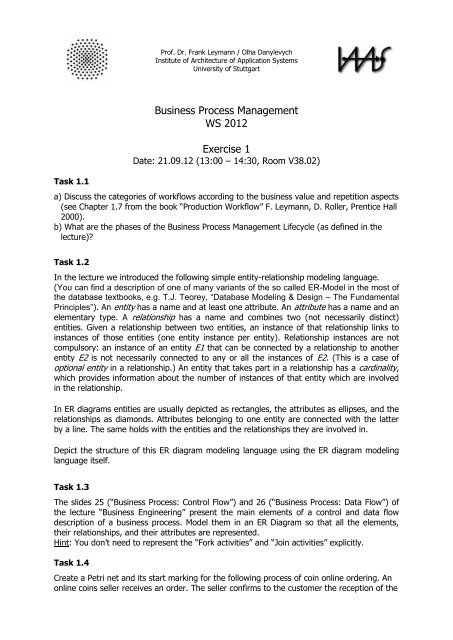Business Process Management WS 2012 Exercise 1 - IAAS
Business Process Management WS 2012 Exercise 1 - IAAS
Business Process Management WS 2012 Exercise 1 - IAAS
You also want an ePaper? Increase the reach of your titles
YUMPU automatically turns print PDFs into web optimized ePapers that Google loves.
Prof. Dr. Frank Leymann / Olha Danylevych<br />
Institute of Architecture of Application Systems<br />
University of Stuttgart<br />
Task 1.1<br />
<strong>Business</strong> <strong>Process</strong> <strong>Management</strong><br />
<strong>WS</strong> <strong>2012</strong><br />
<strong>Exercise</strong> 1<br />
Date: 21.09.12 (13:00 – 14:30, Room V38.02)<br />
a) Discuss the categories of workflows according to the business value and repetition aspects<br />
(see Chapter 1.7 from the book “Production Workflow” F. Leymann, D. Roller, Prentice Hall<br />
2000).<br />
b) What are the phases of the <strong>Business</strong> <strong>Process</strong> <strong>Management</strong> Lifecycle (as defined in the<br />
lecture)?<br />
Task 1.2<br />
In the lecture we introduced the following simple entity-relationship modeling language.<br />
(You can find a description of one of many variants of the so called ER-Model in the most of<br />
the database textbooks, e.g. T.J. Teorey, “Database Modeling & Design – The Fundamental<br />
Principles”). An entity has a name and at least one attribute. An attribute has a name and an<br />
elementary type. A relationship has a name and combines two (not necessarily distinct)<br />
entities. Given a relationship between two entities, an instance of that relationship links to<br />
instances of those entities (one entity instance per entity). Relationship instances are not<br />
compulsory: an instance of an entity E1 that can be connected by a relationship to another<br />
entity E2 is not necessarily connected to any or all the instances of E2. (This is a case of<br />
optional entity in a relationship.) An entity that takes part in a relationship has a cardinality,<br />
which provides information about the number of instances of that entity which are involved<br />
in the relationship.<br />
In ER diagrams entities are usually depicted as rectangles, the attributes as ellipses, and the<br />
relationships as diamonds. Attributes belonging to one entity are connected with the latter<br />
by a line. The same holds with the entities and the relationships they are involved in.<br />
Depict the structure of this ER diagram modeling language using the ER diagram modeling<br />
language itself.<br />
Task 1.3<br />
The slides 25 (“<strong>Business</strong> <strong>Process</strong>: Control Flow”) and 26 (“<strong>Business</strong> <strong>Process</strong>: Data Flow”) of<br />
the lecture “<strong>Business</strong> Engineering” present the main elements of a control and data flow<br />
description of a business process. Model them in an ER Diagram so that all the elements,<br />
their relationships, and their attributes are represented.<br />
Hint: You don’t need to represent the “Fork activities” and “Join activities” explicitly.<br />
Task 1.4<br />
Create a Petri net and its start marking for the following process of coin online ordering. An<br />
online coins seller receives an order. The seller confirms to the customer the reception of the
order, and in parallel he packages of the coins in an envelope. An envelope has a stamp on<br />
it, and is optionally insured. Finally, the envelope is sent over the post and new stamps are<br />
bought.<br />
Task 1.5<br />
Given is the following Petri net N:<br />
1. Identify one reachable marking in N as well as the transition sequence that is required to<br />
reach this marking.<br />
2. Identify one non-reachable marking. Explain why the marking is not reachable.<br />
3. Create a reachability graph for N.
















